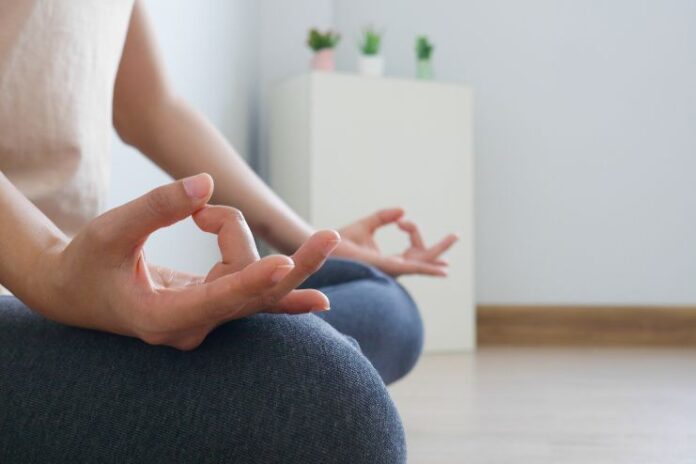Affiliate Disclaimer
Some links in this article are affiliate links. We may earn a small commission if you make a purchase through these links, at no extra cost to you. We only recommend products we find useful to our readersWinter is here! And with it comes the cold and chilly weather that often makes it challenging to stay active and motivated. The thought of having cold and short days may drain our energy and convince us to stay under the blankets without physical exercise.
However, it is essential to maintain a healthy lifestyle even in this season by embracing indoor exercises. Indoor workouts offer a practical and enjoyable way to stay fit during winter. The American Heart Association recommends 150 minutes of moderate-intensity aerobic exercise every week to improve your quality of life.
Whether it is yoga, strength training, or a high-energy dance session, these activities provide an excellent alternative to battle the weather. Exercising indoors helps you burn calories and maintain fitness and boosts mood and energy levels, keeping winter blues at bay.
Interestingly, winter workouts have their own advantages. Cooler temperatures can make exercise more comfortable, while indoor routines eliminate weather-related excuses altogether. There is no need to pause your fitness goals when the mercury drops. Instead, use this time to explore fun and engaging indoor activities that keep your body moving and your mind refreshed.
Don’t let the cold weather keep you from getting your fair share of exercise this winter. Stay active, stay healthy, and enjoy the season with energizing indoor workouts.
READ MORE: Best Exercises For People Who Don’t Like Working Out
Why Indoor Workouts Are Essential in Winter
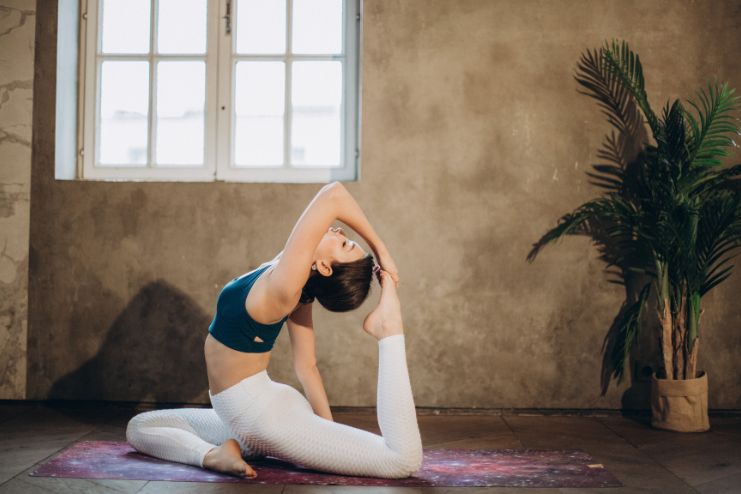
Staying active during winter can be challenging, but winter home exercises make it easier to stay consistent and reap the benefits of regular activity. Here’s why they’re essential:
Overcoming Cold Weather Challenges
Winter’s cold, icy, and often dark conditions can discourage outdoor exercise. Indoor exercises offer a handy and safe substitute, allowing you to stay active without enduring the weather.
Preventing Winter Weight Gain
Comfort meals high in calories and a more sedentary lifestyle are typical throughout the winter. Regular indoor exercise helps burn calories, maintain a healthy weight, and reduce the risk of winter weight gain.
Boosting Immunity and Physical Health
Exercise boosts the immune system, helping you fight off seasonal infections. It also improves heart health, builds muscle strength, and reduces the risk of chronic diseases like diabetes and heart disease.
Supporting Mental Well-Being
Indoor workouts can lift your mood and fight the winter blues, including seasonal affective disorder (SAD). Exercise also reduces stress and anxiety, improves sleep, and increases energy levels.
Convenient and Flexible Options
You can explore various indoor fitness ideas anytime, using minimal equipment like resistance bands or just your body weight. Whether a quick session in your living room or an entire workout in a home gym, indoor exercise fits easily into your schedule. Embrace winter home exercises for a healthy, happy, and active season throughout.
10 Best Indoor Workouts for Winter
Check out the top ten indoor exercises to help you maintain your fitness, improve your mood, and strengthen your immune system. You may perform these simple no-equipment workouts in the convenience of your own home.
1. Bodyweight Circuits
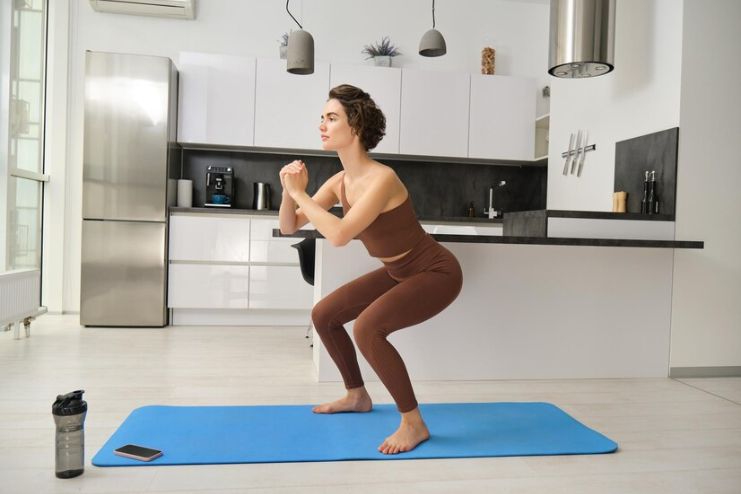
Warm-up recommended: 3 to 5 minutes of light cardio.
Workout: Exercise each one for 30 to 60 seconds, with no more than 10 seconds of rest in between. Depending on your fitness objectives, you can perform the circuits up to six times.
Do two low, quick squats and then two squat jumps. Squat, jump high, then squat again. Perform two of these exercises, one after the other.
Lunge forward with your right foot, and take a step back to lunge forward with your left foot. Repeat for thirty seconds as quickly as you can.
Squat down with your hands on the floor. Put your hands back into a plank position before standing up. If you want to make it more intense, jump at the end. Repeat for 60 seconds.
Start by keeping your hands close together in a push-up position. As you push, rotate to the left and lift your right arm straight into a side plank. After rotating back from that, do a push-up and go into a side plank on the other side. Swap sides and repeat it for 60 seconds.
Benefits: This workout requires no equipment, provides effective full-body toning, and incorporates cardio for improved heart health and calorie burning—all in the comfort of your home.
2. Yoga or Pilates
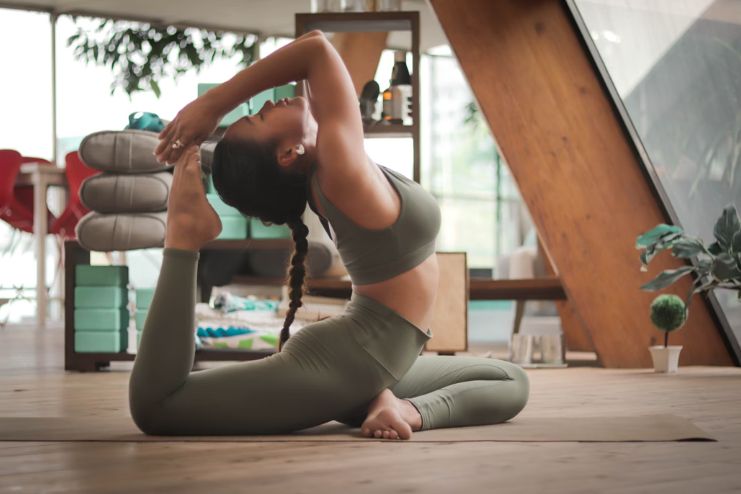
Recommended Time: 3 to 4 times per week.
Workout: Exercise each one for 30 to 60 minutes per session. You can start with shorter sessions of 20 minutes and then move up.
Regular yoga practice will help restore your flexibility and regain the range of motion you may have lost if you were inactive for some time or were never supple. Yoga builds physical strength and flexibility and increases self-awareness of the mind-body-breath connections within each pose, often culminating with a short meditation to close the practice.
Pilates mainly concentrates on the core, with marked exercises of small movements performed in each session. Focusing on the core starts with a brief onset of exercises to instruct how he should move regarding each breath.
Yoga and Pilates are two ways to practice self-acceptance. Both use breathwork to turn inside and dial into their feelings, what’s working, and what might require less support and comfort.
Benefits: Consistent Pilates and yoga practice improves muscle strength, flexibility, and balance. Both help reduce stiffness during the harsh winter season. Their relaxing positions also enhance mental focus.
3. HIIT (High-Intensity Interval Training)
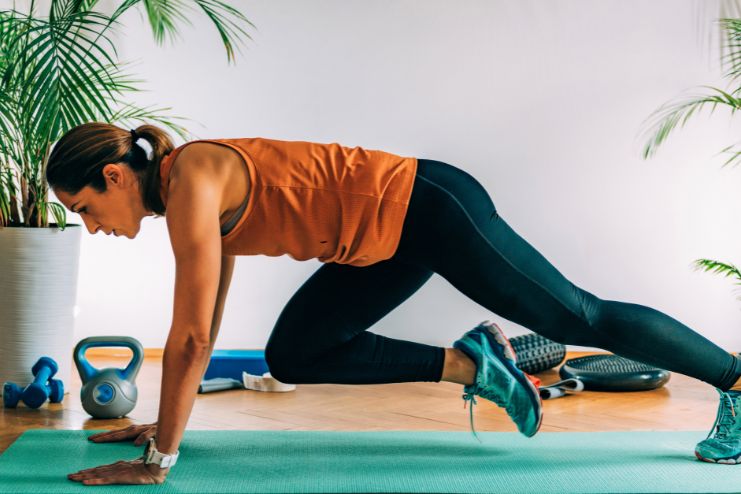
Recommended Time: 2 to 3 times per week.
Workout: You can exercise for 15 to 30 minutes per session. Increase the speed gradually as you improve, starting with 3 to 4 speed intervals.
A good HIIT session usually consists of several rounds of short bursts of high-intensity cardiovascular activity (never more than 20 seconds), followed by rest periods of equal length. This way, you should achieve terrific results in only 30 minutes of workout. It typically requires little to no equipment, and you can choose your preferred cardio method.
A combination of jump squats, push-ups, jumping jacks, and bicycle crunches is a beginner-friendly exercise that you may want to include in your HIIT routine.
Combine kettlebell swings, burpees, bear crawls, and dumbbell overhead presses for the more advanced exercises.
Caution: Your heart will be under strain throughout this workout, so you should see your doctor to determine if HIIT is appropriate for you. If you have joint or muscular issues, such as arthritis, you might be unable to perform HIIT. Start slowly and perform a few intervals for a bit of time.
Benefits: When combined with a regular cardio and strength training plan, high-intensity interval training (HIIT) can quickly improve general fitness, health metrics, calorie burn rate, and competitive performance. It is recommended that you start now and make it a regular habit to stay fit in winter.
4. Indoor Cycling or Stationary Bike

Recommended Time: 2 to 4 times per week.
Workout: Exercise for about 30 minutes per session. Take small breaks of 20 to 30 seconds.
An indoor cycling bike, sometimes called a spin bike, is a dynamic training machine for intense aerobic exercises in your living room or home gym. Because they mimic the feeling of riding a bike outside, these bikes are ideal for exercise enthusiasts of all skill levels. They have several workout modes and customizable intensity.
Push hard in a medium to large gear for forty seconds. After that, rest for 20 seconds. Do this ten times for a single set. Perform two to four sets, taking five minutes off in between.
You can then pedal more efficiently in the subsequent sets. For ten seconds, pedal as hard as you can in a gear that allows you to exert effort to push 90 to 110 rpm. After that, spin lightly for 20 seconds. Repeat for ten to fifteen minutes. For five minutes, pedal gently to recover. Perform one additional set.
Ride as hard as possible for two to three minutes on your next ride. Take two minutes to recover at a leisurely pace. Perform up to three sets.
Benefits: Indoor cycling classes help you shed fat, improve your heart health, and boost your muscle endurance. They are also an effective method for toning your legs and one of great indoor exercises for weight loss.
5. Treadmill or Walking Workouts
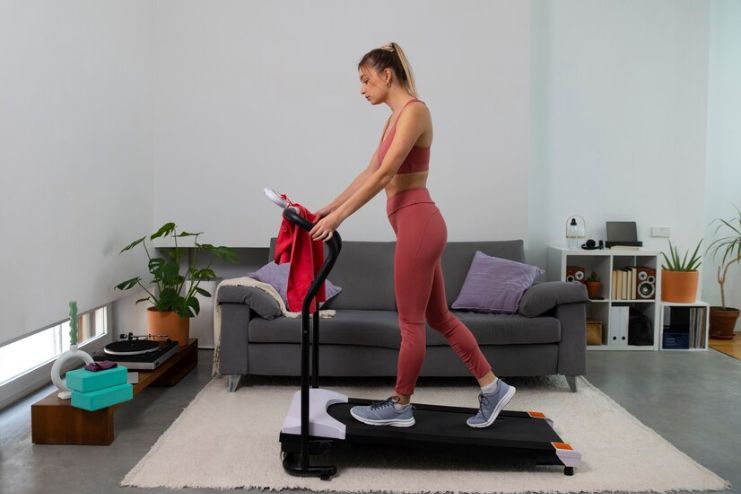
Recommended Time: 3 to 5 times per week.
Workout: Exercise for about 30 to 60 minutes. Keep taking adequate breaks in between the workouts.
Start by taking a one-minute stroll at a leisurely pace. Spend five more minutes warming up with a gentle jog. After warming your muscles and getting your heart rate up, you are ready to work on the treadmill.
Increase the speed for 30 seconds to a hard effort (heavy breathing). A mere 90 seconds of light jogging can help you recover. Do the sprint/recovery intervals nine more times for eighteen minutes.
Running and walking intervals combined in a treadmill workout burn many calories. Start by warming up with three minutes of fast walking or easy jogging. You can also adjust the treadmill inclines. After the 30-minute session is over, take breaks in between the jogs. Try to end with a 5-minute cooldown at a relaxed pace.
Benefits: Treadmill running burns calories more quickly than most other at-home workouts. Exercises on treadmills burn more calories, particularly when combined with different slopes. It is an excellent stress-reduction exercise that improves memory, cognitive function, and general mental clarity, improving focus and productivity in day-to-day activities.
6. Resistance Band Workouts
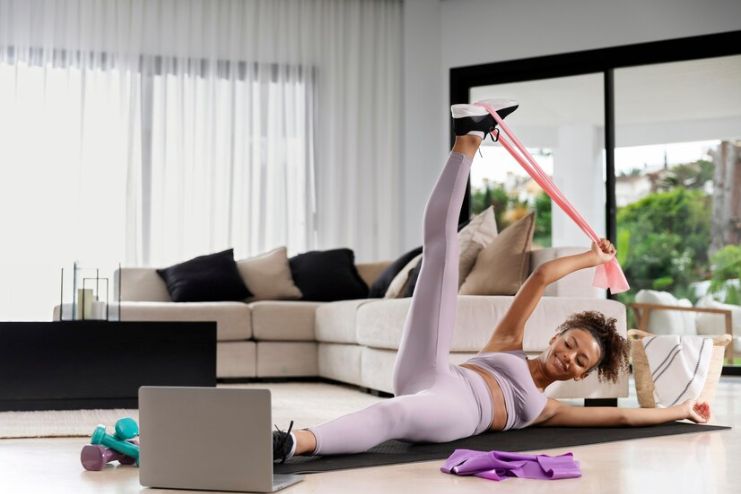
Recommended Time: 2 to 3 times per week.
Workout: Exercise for 2 to 3 sets of 8 to 25 reps per session.
Here are five basic resistance band indoor workouts:
Chest Press: Hold both ends of the resistance band as you wrap it behind your back. Push the band forward by straightening your elbows, hold for one second, then return.
Squats: Stand on the resistance band, holding both ends. From a squat position, raise your knees to stand, then drop them again and repeat.
Biceps Curl: Step on the resistance band and hold it with your arms at your sides. With your elbows bent and your hands facing up, raise the band and hold it there momentarily.
Elastic Band Rows: Hold both ends of the band while fastening it to a door. To draw the band back, flex your elbows while keeping them close to your body.
Clamshells: While resting on your side, wrap a resistance band over your thighs. Keep your feet together, lift your top knee like a clamshell, and switch sides after each set.
Caution: To prevent slippage when using resistance bands, always wear shoes.
Before you work out by connecting the band to a door, give the band a firm tug to ensure it is securely fastened to the door.
Examine bands frequently for indications of deterioration. If they have been subjected to extreme heat or cold, they might break.
Benefits: Resistance band training helps reduce body fat, enhance muscle tone, and improve joint stability. It is an excellent, space-conscious way to engage and build muscles across the whole body.
7. Dance Workouts
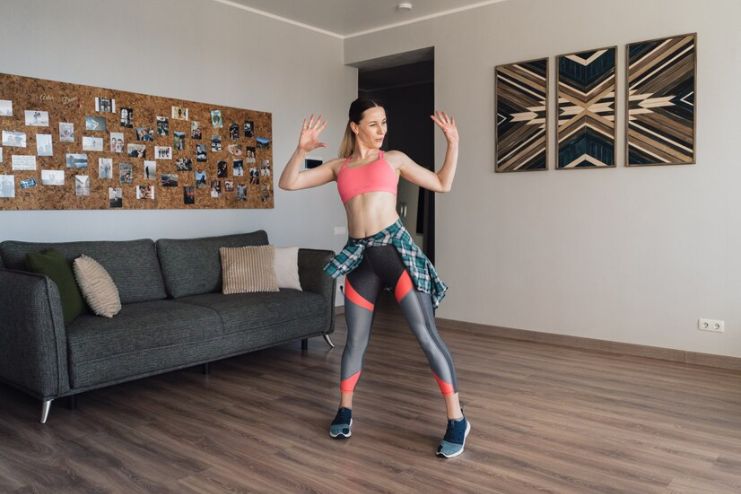
Recommended Time: 3 to 4 times per week.
Workout: Start with 2 to 3 dances per session and move your way up to 20-30 minutes of dance workout.
When simply exercising does not seem any more fun, getting a complete body workout through dance is one of the best solutions. People can choose from many dance workouts, such as Zumba, jazzercise, belly dance, hip-hop dance workouts, and so on.
You can do dance workouts anywhere. There does not have to be a lot of space; it simply has to be a small area comfortable enough for you to do some dance movements.
You can create a playlist supporting a do-it-yourself dance fitness program in your home. You can go for a low-intensity workout or add a little spice with moderate-high intensity. The most important thing is that the workout is fun.
This energetic cardio exercise engages multiple muscle groups of the body, potentially making it more effective than other workouts. These muscular exercises are usually freestyle dancing or improvisational movement, with styles drawn from Latin dance, hip-hop, or Bollywood. Thus, they focus on rhythm and movement rather than technical proficiency.
Benefits: Dance workouts are versatile and require no special equipment, making them easy to do anytime, anywhere. Motivation and a proper diet can help you achieve your fitness goals. Dancing combines cardio and muscular activity for a full-body workout that improves balance, coordination, and muscle tone.
Its lateral and rotational movements enhance muscle definition and strength. Additionally, regular dancing increases flexibility, promoting better posture, mobility, and coordination while reducing the risk of injuries and muscle soreness.
8. Online Workout Classes
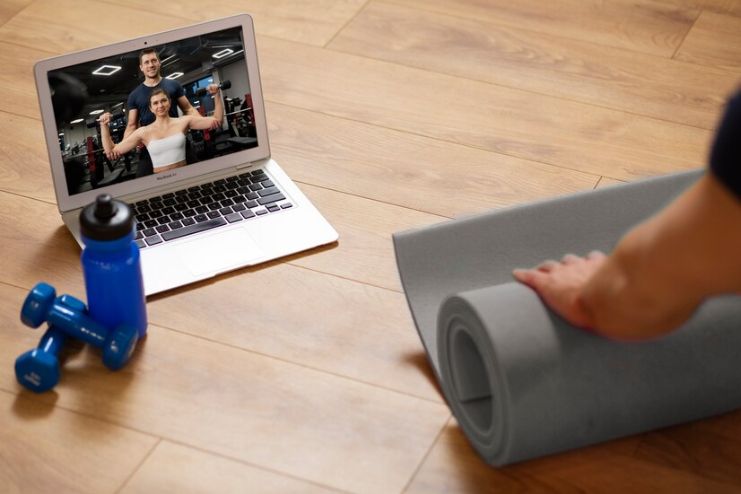
Recommended Time: 3 to 4 times per week.
Workout: At least 30 minutes in one session.
There are several virtual videos for everyone, whether you prefer a lively cardio dance session or a relaxing yoga class. Additionally, since watching the videos is free, you can test out a range of activities, including strength, yoga, and cardio.
Check out some of the videos here:
At-home cardio workouts are beneficial. Even skipping or climbing stairs can be a fantastic cardio workout at home because the primary goal of cardio exercises is to raise the heart rate. Virtual cardiac exercise sessions are offered for more advanced versions.
Donkey kick burpees, mountain climbers, squat jumps, lateral shuffles, plank shoulder taps, crab walks, and high knees are the best aerobic exercises that can be performed at home using internet videos.
Benefits: Aerobic activities, which also aid in burning calories and fat, are primary goals for losing weight. Daily aerobic exercise for 30 minutes at home will improve heart blood flow and reduce the risk of stroke, metabolic syndrome, diabetes, and cardiovascular disease. It elevates mood and lowers stress. It also improves memory and boosts productivity.
9. Strength Training with Dumbbells or Kettlebells
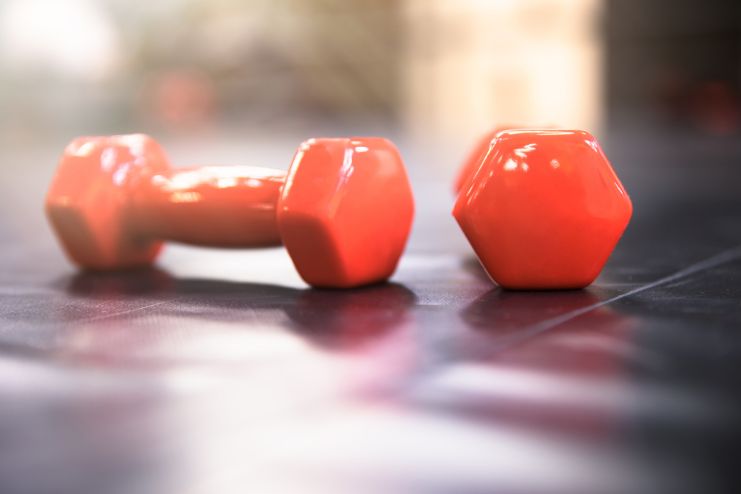
Recommended Time: 3 times per week.
Workout: Exercise for 20 to 30 minutes in one session, taking a break of 60 to 90 seconds between exercises.
Several exercises may be performed using dumbbells. It can be used for various indoor workouts, including cardio and lifting exercises. Another instrumental piece of equipment is a kettlebell.
They are excellent tools to add challenge to your full-body, upper-body, or lower-body workouts because they can be used for the same exercises as dumbbells: pressing, pushing, pulling, lunging, squatting, deadlifting, and carrying.
However, that does not imply that they are interchangeable. Kettlebells are the best tool for some weighted exercises, particularly those that require explosive movement. Their form, consisting of a circular bell bottom and an attached handle, makes them easy to move around.
Moreover, your range of motion will be slightly different when you grasp them from the top, which means your muscles will use other mechanisms.
You can perform workouts like the split squat with dumbbells, the kettlebell squat to high pull, the kettlebell sumo deadlift, the dumbbell breast drag, the frontal plane lunge, and the dumbbell single-arm gorilla row.
Check out some of the exercises here:
Benefits: Kettlebells, as well as dumbbells, can be used to strengthen the body. They also permit low-impact development of power and explosiveness. One can do a complete body workout with just one kettlebell, which makes this exercise option excellent for home gyms where space may be limited.
With the addition of such equipment, not only can strength, endurance, and flexibility be cultivated and targeted to regulate muscle groups, but muscle mass is also accumulated at an increasing rate. These exercises increase metabolism and improve posture.
10. Indoor Sports

Recommended Time: 3 to 5 times per week.
Workout: Exercise for 30 to 60 minutes. Take occasional breaks to hydrate yourself.
Indoor sports come in handy when outdoor activities become difficult owing to icy conditions or reduced daylight hours. Basketball, badminton, table tennis (ping pong), volleyball, and squash or racquetball are popular indoor sports to try in winter.
Basketball: Basketball is a classic indoor activity that combines cardio, coordination, and cooperation. Many local gyms and recreation centers have open courts, making them accessible even in small towns.
Badminton: Easy to set up in a gym or even a large indoor space, badminton is played using shuttlecocks and lightweight rackets. The game can be adjusted to suit players of different skill levels, making it ideal for friendly matches or family time.
Table Tennis or Ping Pong: Table tennis requires little room and equipment and is a fun and competitive activity that enhances reflexes and hand-eye coordination.
Volleyball: Indoor volleyball provides an intense workout that tones your core and upper body. It is also a fantastic method for improving communication and teamwork.
Squash and Racquetball: Winter is ideal for these racquet sports because they are played on enclosed courts. Squash and racquetball are fast-paced sports that enhance cardiovascular fitness, agility, and hand-eye coordination. They are also great stress relievers and can be played in teams or individually.
Benefits: Indoor sports offer numerous advantages, combining exercise with social engagement. They improve hand-eye coordination, reaction time, and mental alertness while reducing the risk of injury in controlled environments. Participating in indoor sports promotes stress relief, enhances well-being, and fosters a sense of belonging through social interaction.
Additionally, they aid skill development, teamwork, and sportsmanship. Healthy competition boosts confidence and provides a sense of achievement. Lastly, indoor sports are an enjoyable way to improve fitness and burn calories.
Tips for Maximizing Your Indoor Workouts
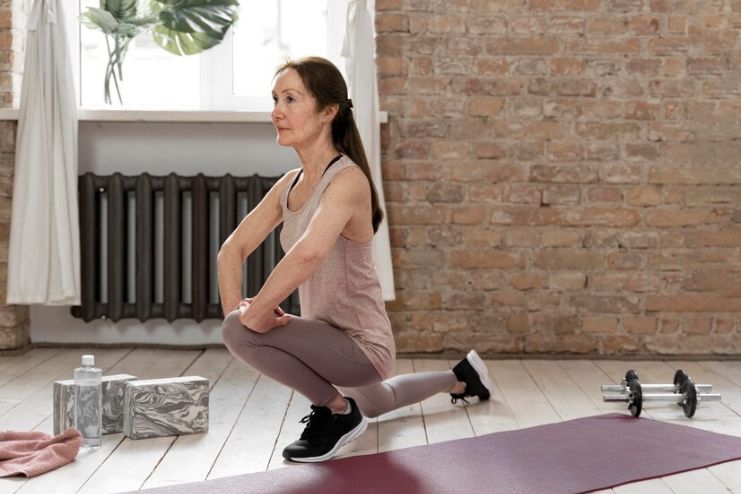
Maximizing indoor workouts can be effective and enjoyable with the right approach. You can enjoy the best cardio workouts at home by implementing specific strategies while staying healthy and active all year round. Here are five tips to enhance your indoor workout routine and stay active:
Set a Dedicated Workout Space at Home
Choose a separate space in your home for exercising to create a focused setting. This room must not be vast; simply a tiny nook can suffice. A constant workout location helps build a pattern and reduces distractions, making sticking to your fitness goals more straightforward.
Invest in Basic Equipment
Equipping your home gym with essentials like a yoga mat, resistance bands, and dumbbells can significantly enhance your workouts. These items are versatile and suitable for various exercises, from strength training to flexibility routines. Such tools ensure you can effectively target multiple muscle groups for the best indoor workouts.
Use Fitness Apps or YouTube for Guided Routines
Leverage technology to access a plethora of guided workout routines. Fitness apps and YouTube channels offer structured classes ranging from yoga to high-intensity interval training (HIIT). These platforms provide engaging options to keep your indoor workout routine diverse and motivating.
Keep a Consistent Schedule to Maintain Momentum
Creating and sticking to a consistent workout routine is critical for developing and sustaining fitness habits. Consistency is key to progress, whether morning yoga or evening strength training.
Incorporate Indoor Walking Workouts
Indoor walking is a simple yet effective way to stay active, particularly in limited spaces. It is a low-impact exercise that boosts cardiovascular health and easily fits into your routine.
Conclusion

Staying active indoors during winter is an excellent way to maintain your health and well-being while adapting to seasonal challenges. Adding different types of indoor workouts to your past routine will improve your mental and physical health.
It also boosts immunity, improves heart or cardiovascular health, and increases emotional stability. You might indulge yourself in yoga or strength training, dancing, or even walking inside your living room; you just need to find fun and effective ways to make it possible to stay healthy.
Fitness does not depend on the season but on your attitude. Following cold weather fitness tips and engaging in indoor exercises during winter keeps you on track, away from completely derailing your fitness plan. Working in sweaty workouts will let you reap the benefits of a healthy and active routine throughout the year.
So, wear your workout clothes, try something new, and keep moving! With indoor workouts, staying fit and energized during winter is achievable and enjoyable.
References
- https://www.truemeds.in/blog/winter-workouts
- https://www.fitfoodfunlife.com/blog/indoor-workouts-to-get-you-through-winter
- https://www.heart.org/en/healthy-living/fitness/getting-active/how-to-stay-active-in-cold-weather
- https://www.drwadiwala.com/blog/10-indoor-exercises-to-keep-you-fit-when-its-too-cold-outside
- https://www.baptist-health.com/blog/10-indoor-alternative-workouts-to-try-this-winter
- https://blog.movegb.com/10-home-workouts-for-when-its-too-cold-to-leave-the-house
- https://sunnyhealthfitness.com/blogs/health-wellness/12-best-indoor-activities-to-avoid-the-cold-winter
- https://cbphysiotherapy.in/blog/staying-active-during-delhi-winters-top-10-exercises-for-cold-weather-by-cb-physiotherapy
- https://www.linkedin.com/pulse/physical-fitness-home-maximizing-your-workout-routine-irina-shehovsov-cbkge/
- https://www.trainerroad.com/blog/indoor-training-advice-for-beginners/
- https://www.self.com/story/best-physical-therapy-tools
- https://www.dailytelegraph.com.au/lifestyle/get-fit-for-less-than-100/news-story/e92946a8e180d5426cc602b916e12817
- https://www.verywellhealth.com/indoor-walking-workout-8729016
- https://www.verywellfit.com/10-minute-body-weight-circuit-workout-1231502
- https://www.vogue.com/article/pilates-vs-yoga
- https://health.clevelandclinic.org/yoga-vs-pilates
- https://www.chicagoathleticclubs.com/blog/what-is-dance-fitness
- https://www.cult.fit/live/fitness/workout-formats/cardio/DIYLIV03/p
- https://www.goodhousekeeping.com/health/fitness/g33326349/best-youtube-workouts/
- https://www.self.com/gallery/beginner-kettlebell-moves
- https://gymgear.com/top-10-dumbbell-exercises-for-a-full-body-workout/
- https://mensfitness.co.uk/workouts/dumbbell-and-kettlebell-workout
In this Article















